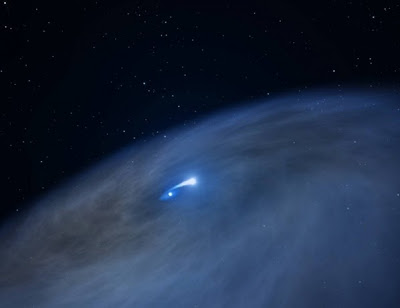 |
| Source: NASA |
The NASA’s Hubble telescope, one of the most powerful telescopes in the world, has spotted something that has never been observed before. The telescope has noticed something different in this star. Although the star was discovered about 10 years ago and was categorized as a Wolf-Rayet star, a continuously evolving star that is much bigger than Sun, it has been named Nasty1 because of its weird behavior. The star loses its hydrogen-filled outer layers quickly, bringing its super-hot and extremely bright helium-burning core to the fore.
Being named as a star does not mean that it also looks like a normal Wolf-Rayet star. It was revealed through the Hubble telescope that Nasty1 had a Pancake-shaped disk of gas around the star. The width of the disk was revealed to be about two trillion.
According to the recent estimates, the nebula around the star is just a few thousand years old which is quite young in astrophysics. The distance of the star is thought to be 3,000 light-years from the Earth.
The astronomers have said that this disc is the result of an exceedingly rare occurrence which happens when two Wolf-Rayets are formed within the same solar system and the smaller star siphon’s off the others hydrogen fuel.
“We were excited to see this disk-like structure because it may be evidence for a Wolf-Rayet star forming from a binary interaction,” explained study leader Jon Mauerhan from the University of California-Berkeley in a comment to the press.
This is a very rare event in action as for most of the processes, their phase is short lived. Its lifespan could last only for a hundred thousand years while the scale over which a resulting disk is visible could be only ten thousand years or less.































